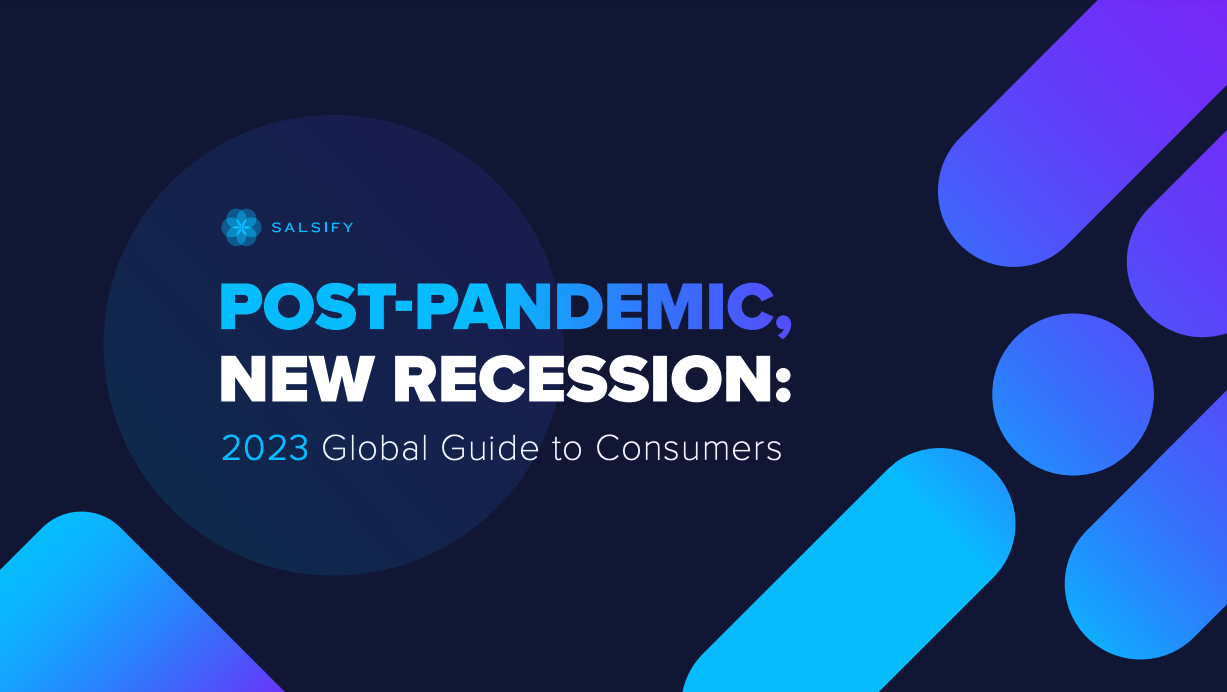

Post-Pandemic, New Recession: 2023 Global Guide to Consumers
Download the full report to learn how you can leverage customer experience data to create unforgettable shopping experiences and win the digital shelf.
DOWNLOAD REPORTPIM
Manage all product content in one central system of record.
Syndication
Easily syndicate product content to every consumer touch point.
Enhanced Content
Enrich product pages with below-the-fold content and rich media.
Intelligence Suite
Bring AI-powered capabilities directly into your Salsify workflows.
Grocery Accelerator
Leverage the first-ever category-wide PXM accelerator in the grocery industry.
GDSN Data Pool
Synchronize standard supply chain, marketing, and ecommerce attributes globally.
Digital Shelf Analytics
Continuously optimize your organization’s product content syndication.
Catalog Sites
Share secure, on-brand, and always up-to-date digital product catalogs.
Automation and AI
Automate business processes and enhance Salsify workflows with AI.
PXM Platform, Integrations, and APIs
Integrate the PXM platform with the rest of your enterprise systems architecture.
Supplier Onboarding
Accelerate supplier onboarding while ensuring your schema requirements are met.
Product Listing
Sell products faster with Product Listing.
Content Enrichment
Increase online conversions with Content Enrichment.
Automation
Save time and increase operational efficiency with retail automation.
SXM Platform, Integrations, and APIs
Integrate the SXM platform with the rest of your enterprise systems architecture.
Syndication Network
Automate how you exchange product content data to the digital shelf.
Enhanced Content Network
Turn product pages into product experiences with Enhanced Content.
Commerce Platform Integrations
Create winning product experiences everywhere shoppers are, including on owned sites.
GDSN Data Pool
Synchronize standard supply chain, marketing, and ecommerce attributes globally.
Open Catalog
Connect to the digital shelf faster with an open, standardized, and free product catalog.
Resources
Resource Library
Explore our ecommerce resources to get everything you need to win on the digital shelf.
Blog
Read our blog to get actionable insights for navigating changing markets and industry demands.
Webinars
Watch our on-demand ecommerce webinars to gain expert advice and tips from our community of industry leaders.
Customer Blog
Gain the latest tips, industry trends, and actionable ecommerce insights.
Knowledge Base
Investigate our knowledge base to build your Salsify skills and understanding.
API
Examine our comprehensive API and webhook guides to start working with Salsify quickly.

Download the report to get expert insights, consumer research, and top industry trends.

Consumers have no shortage of highly personalized, exclusive, and convenient shopping experiences — both in-person and online.
With a click of a button, a consumer sitting in their living room can take a short quiz,virtually try on frames, and order the perfect pair of new glasses to be delivered right to their doorstep. Similarly, many global makeup and clothing brands use technology to match consumers with a personal stylist who’ll handpick items for individual consumers.
While high-quality experiential shopping experiences make for happy consumers, they also result in higher consumer expectations. And if companies want to keep up, they have to understand their customers and cater to their preferences.
Gain a closer look at how brands and retailers can leverage customer experience data to provide top-notch customer experiences that win customers over time and again.
Customer experience data is any information a company collects about a customer's interactions and perceptions of a company, product, or service.
This data can include the following:
Organizations can capture this data through market research methods (e.g., surveys, online communities, and interviews), third-party data like tracking pixels, and first and zero-party data.
Customer experience data is essential to brands and retailers because it shows exactly what your consumers expect, how they respond to different interactions with your company, and whether or not they like your company.
To quantify this, 74% of consumers (Forbes) are at least somewhat likely to buy based on experiences alone, and 86% of consumers (Emplifi) would abandon a brand after just two poor experiences.
To sum it up, customer experience data gives you the information you need to keep your customers happy and loyal — and that affects your revenue.
Before diving into how retail brands use customer experience data, it’s critical to note that not all data collection methods are created equally.
Gartner reports that poor data quality is responsible for an average of $15 million in yearly losses. This figure highlights why retail brands must invest in data governance, which allows you to keep track of and clean your data and measure its accuracy.
Assuming your data collection methods are top-notch, here are the three ways you can use your data to improve your retail business and provide excellent customer experiences.
According to McKinsey & Company’s “Next in Personalization 2021 Report,” 71% of customers want personalized shopping experiences, and 76% are frustrated when they don’t receive them.
Capturing the right data provides demographic information, location data, and customer preferences that retailers can use to personalize shopping experiences.
For example, through web and app tracking, retailers can monitor what products customers are browsing online and send a promotional email to the customer with deals on those specific items.
The truth hurts: If customers don’t like your product, they won’t continue to buy it — no matter how good your marketing strategy and tactics are.
The best retail brands keep tabs on how customers feel about their products and services. And they do this by asking customers directly through surveys. Some common customer survey strategies include a NPS and CSAT.
An NPS survey is a one-question survey that asks customers how likely they are (on a scale of one to 10) to recommend a retailer based on their interaction with the company. If the company gets a low rating, it can contact the customer directly for more detailed feedback.
A CSAT measures how customers feel about a particular product, service, or overall experience. Customer satisfaction surveys also often include open-ended questions that allow customers to provide qualitative feedback. CSATs are a great tool for identifying customer pain points and improving the overall customer experience.
When retail brands understand how customers feel about their products or services, it’s easy to make changes to satisfy their target market.
Today’s marketers don’t waste marketing spend on guesswork. Instead, they double down on customer experience and attribution data to fine-tune their marketing messages and maximize their ad spend.
Accurate customer experience data tells marketers who their customers are, what they prefer, and what and how they buy. Marketers and advertisers use this information to create more focused marketing campaigns that target the right audience.
Your customers are the lifeblood of your business. If you’re not tapped into who they are, how they feel about your company and your products, and their preferences, it will be challenging for your retail brand to thrive.
The best way to stay ahead of the curve is to capture and leverage customer experience data to personalize your customer experiences, improve your products, and inform your marketing messages.

Download the full report to learn how you can leverage customer experience data to create unforgettable shopping experiences and win the digital shelf.
DOWNLOAD REPORTAshley R. Cummings (she/her) is a freelance writer specializing in ecommerce software as a service (SaaS). Her words appear across the web in places like Insider, LinkedIn, ShopifyPlus, and Hashtagpaid.
Standing out on the digital shelf starts with access to the latest industry content. Subscribe to Below the Fold, our monthly content newsletter, and join other commerce leaders.